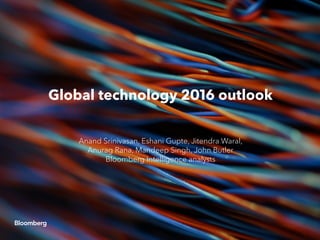
Global technology 2016 outlook
- 1. Global technology 2016 outlook Anand Srinivasan, Eshani Gupte, Jitendra Waral, Anurag Rana, Mandeep Singh, John Butler Bloomberg Intelligence analysts
- 2. Global technology hardware 2016 outlook
- 3. Tech hardware disruption has no relief in sight
- 4. Mergers and spinoffs won’t alter virtualization, commoditization and cloud architecture trends in hardware. Dell-EMC and Hewlett Packard Enterprise may continue to struggle for sales growth amid more competition from Lenovo. Cheaper servers are growing at Amazon and Microsoft clouds. PCs and tablets remain weak due to Asia macroeconomic challenges. A shift in storage from networked systems into direct-attach and solid-state drives hurts EMC and NetApp sales. The transition to “hybrid” clouds may be slow.
- 5. Clouds, virtualization, Asia commoditize hardware
- 6. Growth in public clouds from Amazon, Facebook and Google, along with emerging market growth, will continue to commoditize technology hardware. Many companies in these segments use lower-cost, local or non-branded hardware made by Quanta, Mitac and Sugon, relying less on Hewlett Packard Enterprise, Cisco and Dell. These trends, along with Lenovo’s cost-optimized presence in servers, may boost competition and damp pricing and margins. Branded vendors are turning to corporate clouds, which may be slower to develop.
- 7. Software model, solid-state drives upend storage
- 8. Software’s pervasion through hardware has altered servers and is encroaching on storage. Virtualized servers mostly use direct-attached storage with Seagate or Western Digital drives, controlled by software from VMware, Microsoft or Citrix. NAND-based solid-state drives are also gaining ground. These models, and hyperscale consumers’ use of original design manufacturers, will accelerate hardware commoditization, polarize storage and reduce the use of costly networked storage from EMC and NetApp.
- 9. Stronger Windows 10, aging PCs may drive upgrades
- 10. Microsoft’s Windows 10 has the potential to create a strong PC upgrade cycle lasting several quarters. With an installed base of 1.67 billion PCs, Intel estimates there are about 600 million units more than four years old, which is one potential driver of upgrades. The quality of Windows 10, and its relatively bug-free status compared with prior versions, is another factor. Holiday shopping in the U.S. and western Europe in 2H might provide a boost to sales of newer PC models, after a seasonally weaker 1H.
- 11. Global IT faces macro issues amid tech disruptions
- 12. Median trailing 12-month sales growth for the top technology companies on a global basis, including hardware, semiconductors, software and services are projected to expand modestly in 2016 to 9% from 8% in 2015, consensus data show. Across market-caps, growth changes appear meager. Software companies are projected to expand by double digits, while many other groups including hardware and electronics manufacturing hover at or below 5% growth. Large U.S.-based hardware companies may remain growth-challenged.
- 13. Global infrastructure software 2016 outlook
- 14. Tech companies make software key differentiator
- 15. Commoditization of hardware will continue to drive software as the primary differentiator for technology companies in 2016. All sections of the cloud -- infrastructure, platform and applications -- should see greater spending as companies move away from a client-server IT architecture. Greater demand for connected devices, along with increased cyberattacks, may fuel more security software spending. A software vendor’s ability to provide advanced analytics may become a key distinguishing factor in the market place.
- 16. Gap among cloud leaders, laggards likely to widen
- 17. In cloud Infrastructure-as-a-Service, the gap between leaders Amazon, Microsoft and Google and the rest of the market will likely widen in 2016. The scale of these vendors, along with constant price cuts should create greater barriers to entry for basic cloud compute and storage services. This will force other companies to focus more on the hybrid cloud, which combines public and private cloud resources and has higher margins. However, in cloud applications, competition from legacy software vendors may intensify.
- 18. Security software demand likely to remain strong
- 19. The number and sophistication of cyber-attacks will likely continue to grow in 2016. Consequently, spending on advanced security products will increase 28% annually through 2019, according to IDC. Greater use of connected devices in the workplace opens up networks to more intrusions and companies will put greater emphasis on security software at endpoints such as mobile devices. Large tech vendors will likely continue to pursue acquisitions for advanced security products.
- 20. Analytics may be main differentiator in software
- 21. The ability of cloud application vendors to provide advanced analytics on their core products may become the single biggest distinguishing factor in the year-ahead. Machine-learning and other advanced data analysis methodologies are becoming increasingly important for clients to better understand their user-base. Rising use of Internet of Things products will also fuel demand for analytics. Pure-play visualization vendors will likely expand their product portfolio as competition increases.
- 22. Virtualization moves from servers to network
- 23. The adoption of virtualization software in the network and storage layers of data centers will likely accelerate in 2016. Server virtualization growth rates have plateaued, prompting software vendors to target other areas in data centers. OpenStack adoption in data centers is also likely to increase and threaten the margins of legacy vendors including IBM and Cisco. Greater use of mobile devices for both personal and business use will continue to drive the need for mobile-device management software.
- 24. Bloomberg Intelligence offers valuable industry and company data, interactive charting and written analysis with government and credit insights from a team of independent experts, giving trading and investment professionals deep insight into where crucial industries stand today and where they may be heading next.
